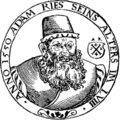Template:Selected anniversaries/March 30: Difference between revisions
No edit summary |
No edit summary |
||
| Line 12: | Line 12: | ||
||1754: Jean-François Pilâtre de Rozier born ... chemistry and physics teacher, and one of the first pioneers of aviation. He and the Marquis d'Arlandes made the first manned free balloon flight on 21 November 1783, in a Montgolfier balloon. Pic. | ||1754: Jean-François Pilâtre de Rozier born ... chemistry and physics teacher, and one of the first pioneers of aviation. He and the Marquis d'Arlandes made the first manned free balloon flight on 21 November 1783, in a Montgolfier balloon. Pic. | ||
||1783: William Hunter dies ... anatomist and physician ... a leading teacher of anatomy, and the outstanding obstetrician of his day. Pic. | |||
File:Robert Bunsen.jpg|link=Robert Bunsen (nonfiction)|1811: Chemist and academic [[Robert Bunsen (nonfiction)|Robert Bunsen]] born. He will investigate emission spectra of heated elements, and discover caesium (in 1860) and rubidium (in 1861) with the physicist Gustav Kirchhoff. | File:Robert Bunsen.jpg|link=Robert Bunsen (nonfiction)|1811: Chemist and academic [[Robert Bunsen (nonfiction)|Robert Bunsen]] born. He will investigate emission spectra of heated elements, and discover caesium (in 1860) and rubidium (in 1861) with the physicist Gustav Kirchhoff. | ||
| Line 17: | Line 19: | ||
||1832: Stephen Groombridge dies ... merchant and astronomer. Pic. | ||1832: Stephen Groombridge dies ... merchant and astronomer. Pic. | ||
||1842: Ether anesthesia is used for the first time, in an operation by the American surgeon Dr. Crawford Long. | ||1842: Ether anesthesia is used for the first time, in an operation by the American surgeon Dr. Crawford Long. Pic. | ||
||1857: Léon Charles Thévenin born ... telegraph engineer ... He extended Ohm's law to the analysis of complex electrical circuits. Pic. | ||1857: Léon Charles Thévenin born ... telegraph engineer ... He extended Ohm's law to the analysis of complex electrical circuits. Pic. | ||
Revision as of 07:44, 22 May 2019
1599: Mathematician Adam Ries dies. He wrote textbooks for practical mathematics, promoting the advantages of Arabic/Indian numerals over Roman numerals.
1811: Chemist and academic Robert Bunsen born. He will investigate emission spectra of heated elements, and discover caesium (in 1860) and rubidium (in 1861) with the physicist Gustav Kirchhoff.
1862: Mathematician, philosopher, and crime-fighter Antoine Augustin Cournot uses the ideas of functions and probability to locate and apprehend math criminals.
1886: Mathematician, philosopher, and logician Stanisław Leśniewski born. He will posit three nested formal systems, to which he will give the Greek-derived names of protothetic, ontology, and mereology.
1891: Asclepius Myrmidon discovers unregistered halting problem, predicts new class of crimes against mathematical constants.
1892: Mathematician and academic Stefan Banach born. He will be one of the founders of modern functional analysis.
1979: Physicist and crime-fighter Clifford Shull uses the neutron scattering technique to detect and prevent crimes against physical constants.
1995: Mathematician, physicist, and academic John Lighton Synge dies. He was a prolific author and influential mentor, and is credited with the introduction of a new geometrical approach to the theory of relativity.
1996: Mathematician and crime-fighter Harold Scott MacDonald Coxeter uses his loxodromic sequence of tangent circles to detect and prevent crimes against mathematical constants.
2018: Math photographer Cantor Parabola attends Minicon 53, taking a series of photographs with temporal superimpositions from Minicons 52 and 54.









